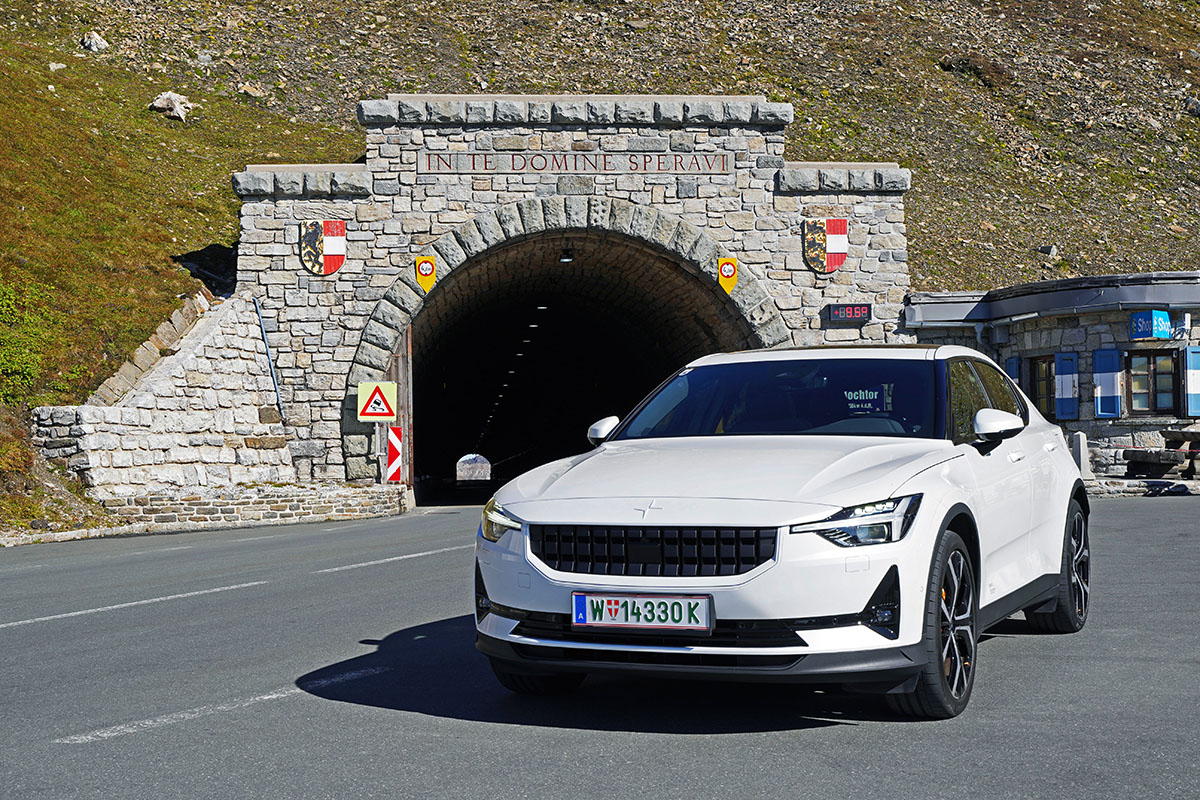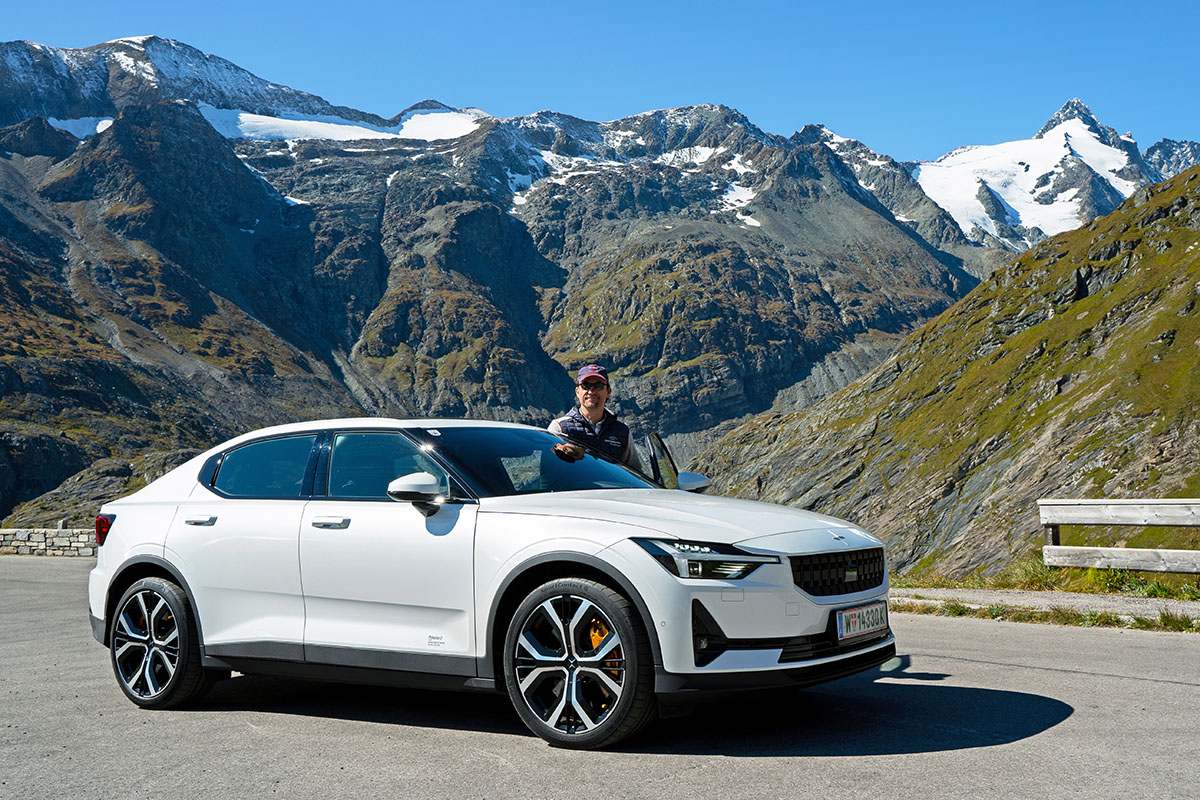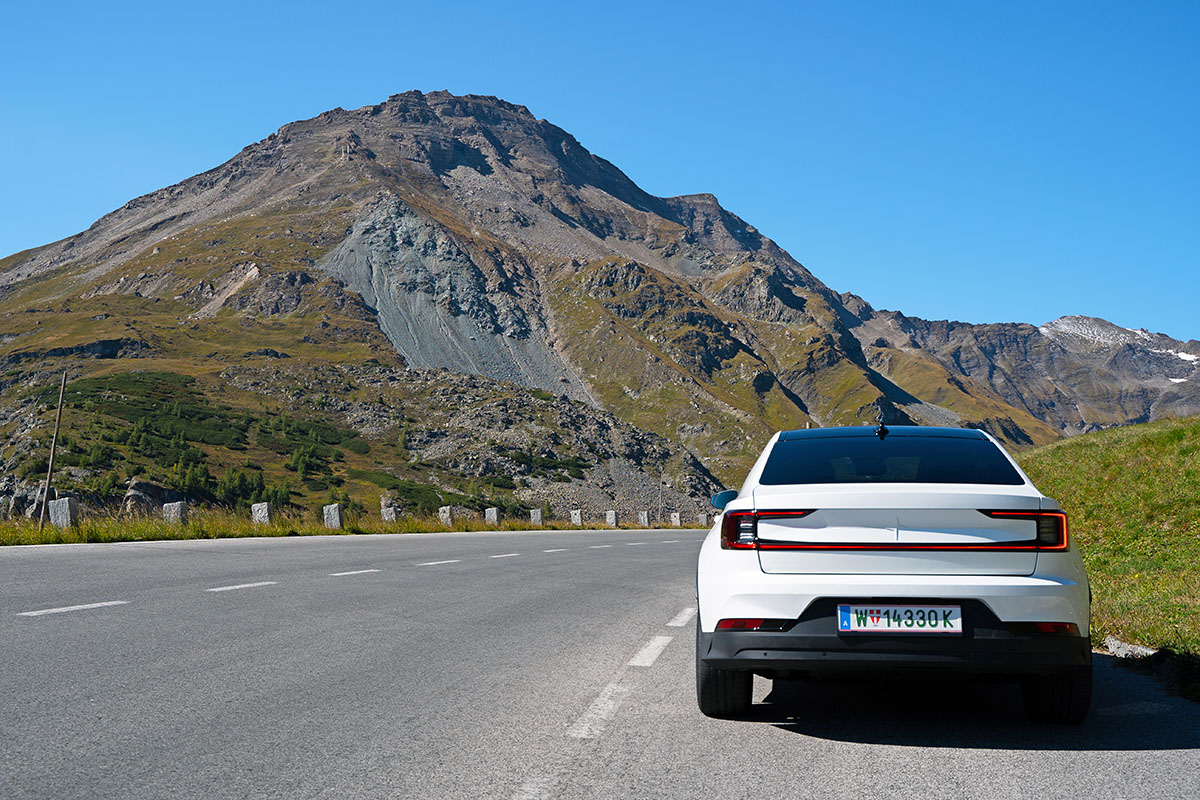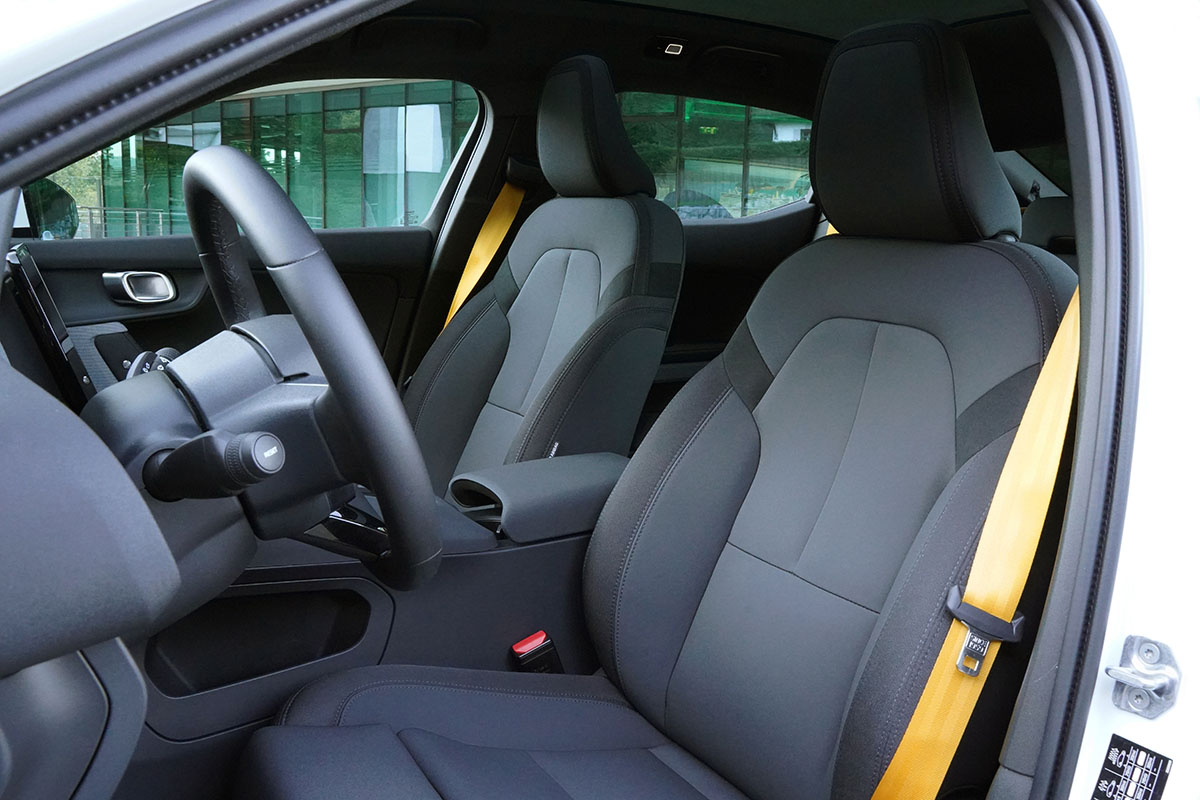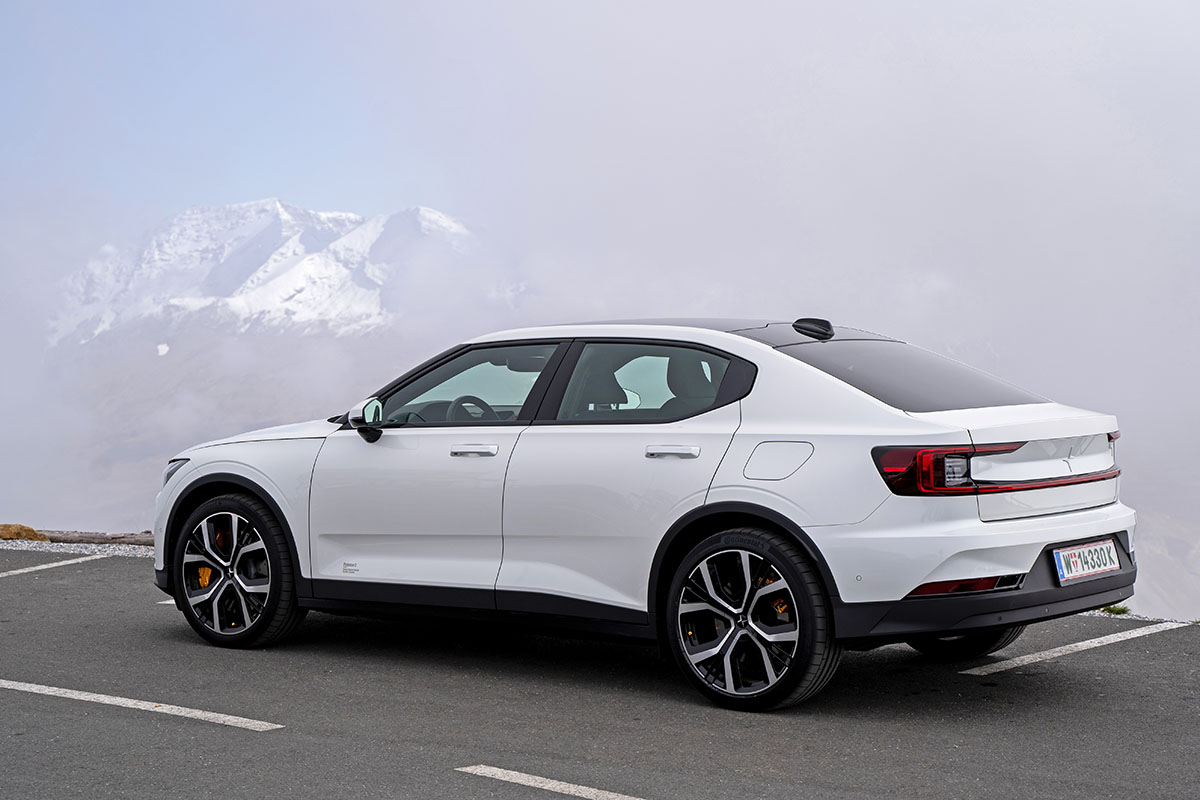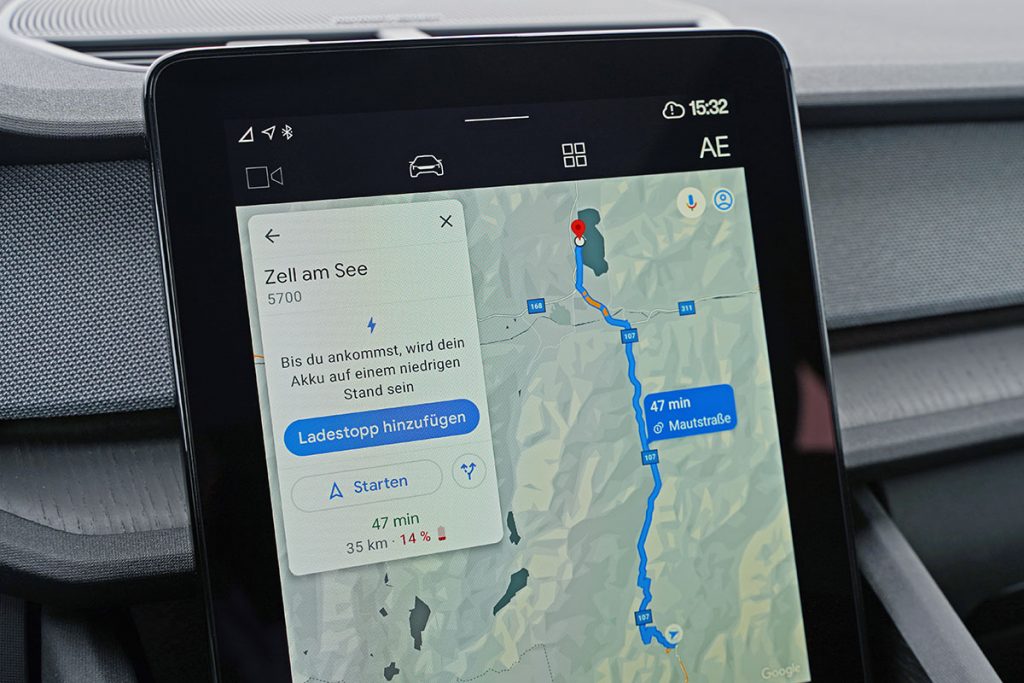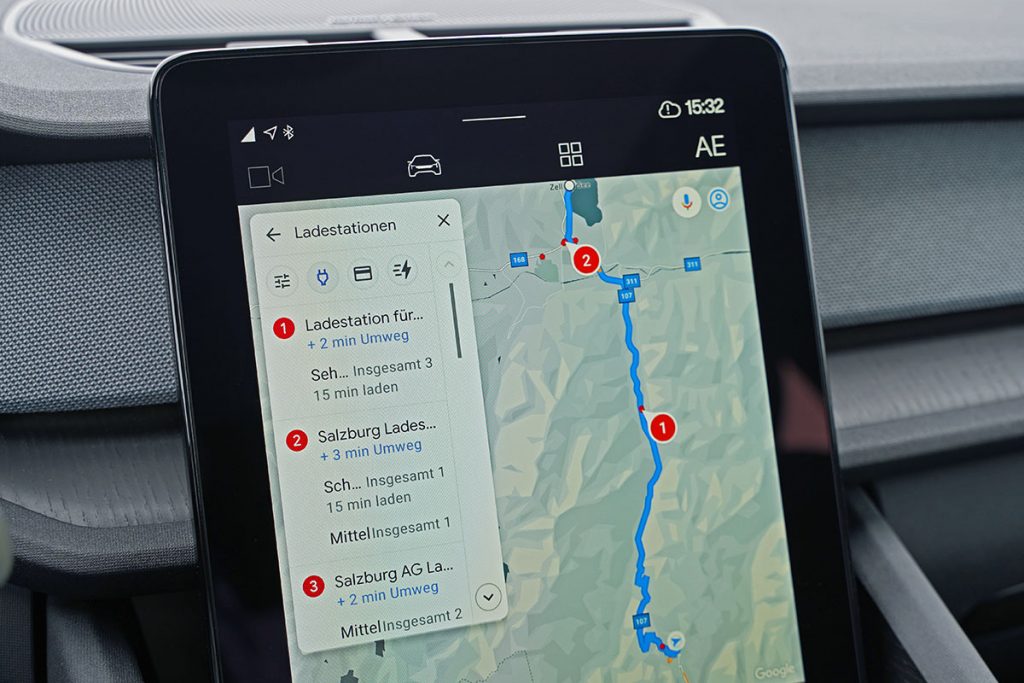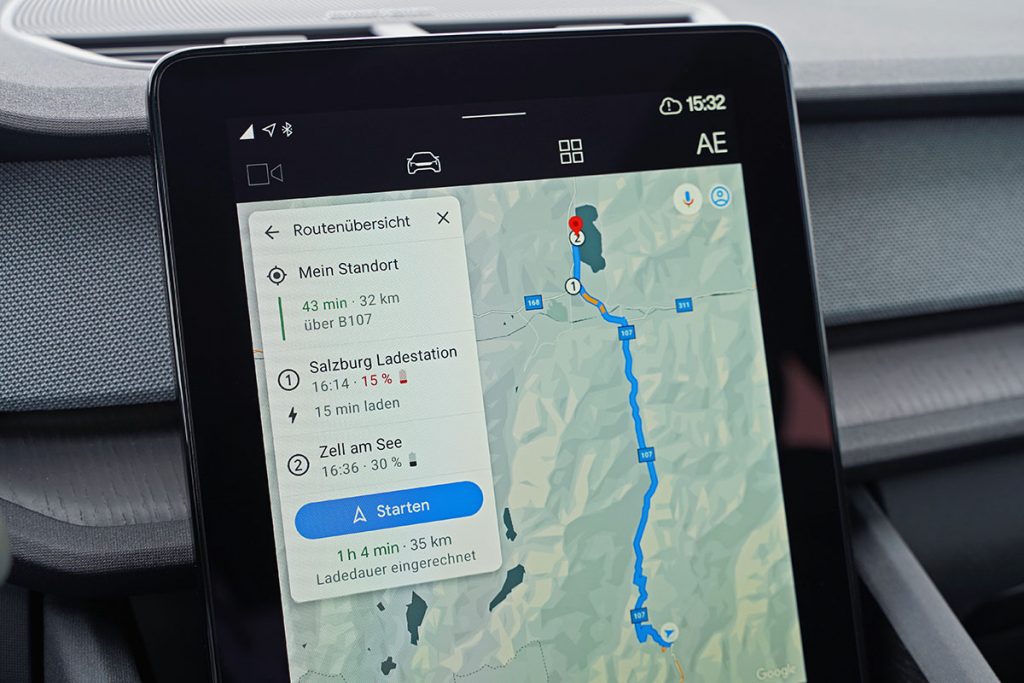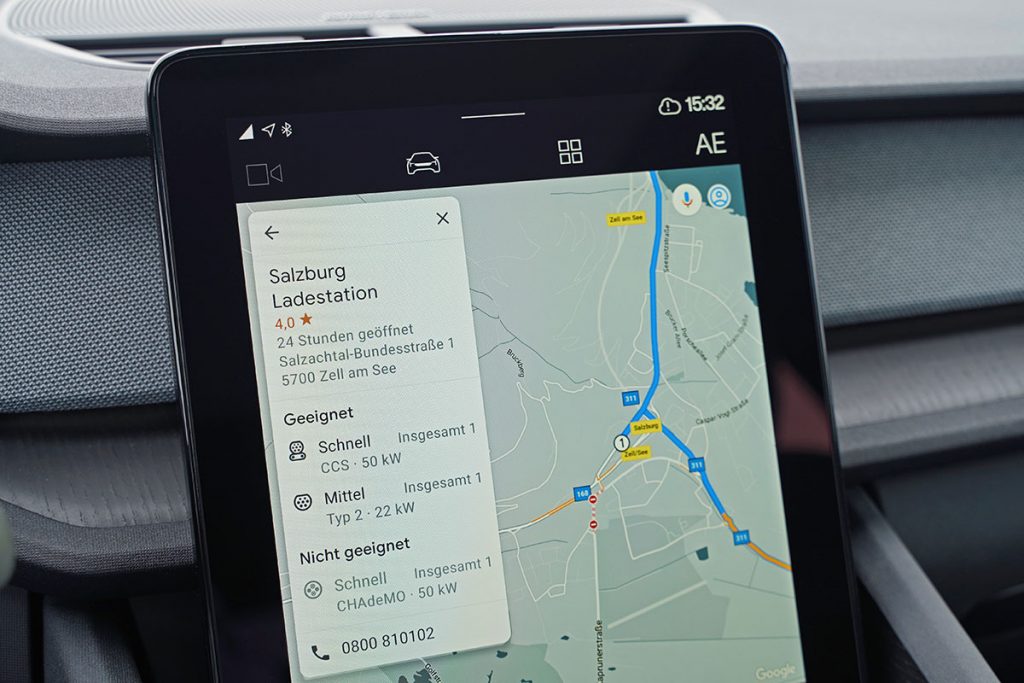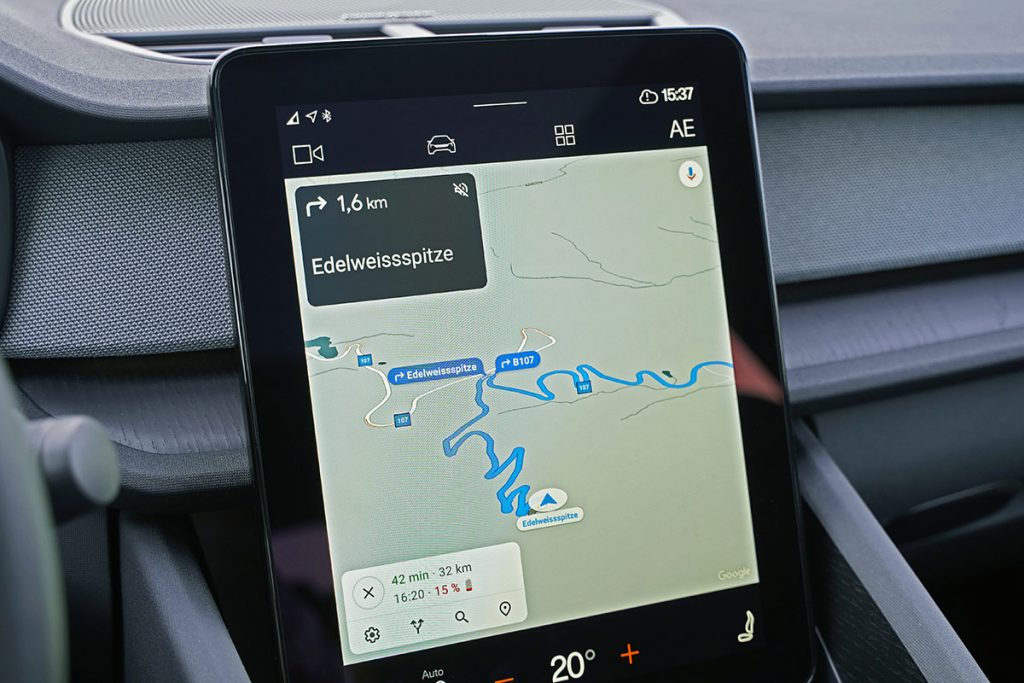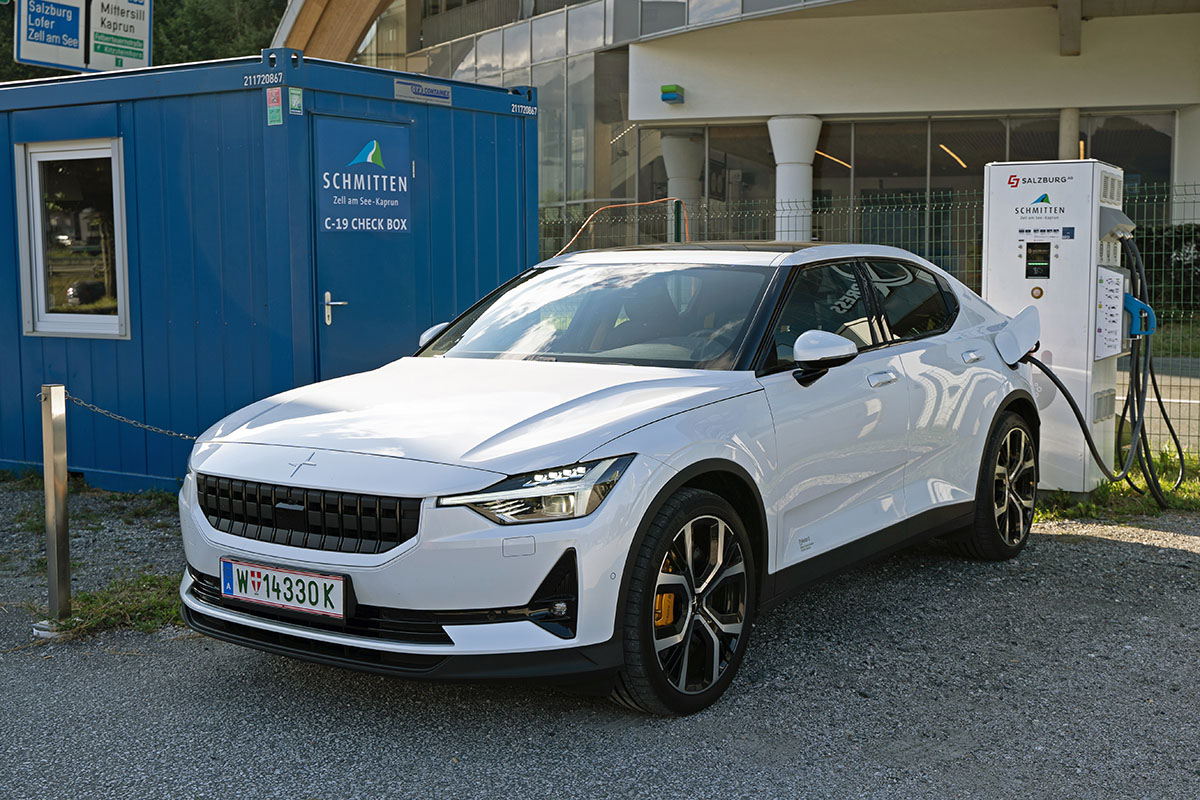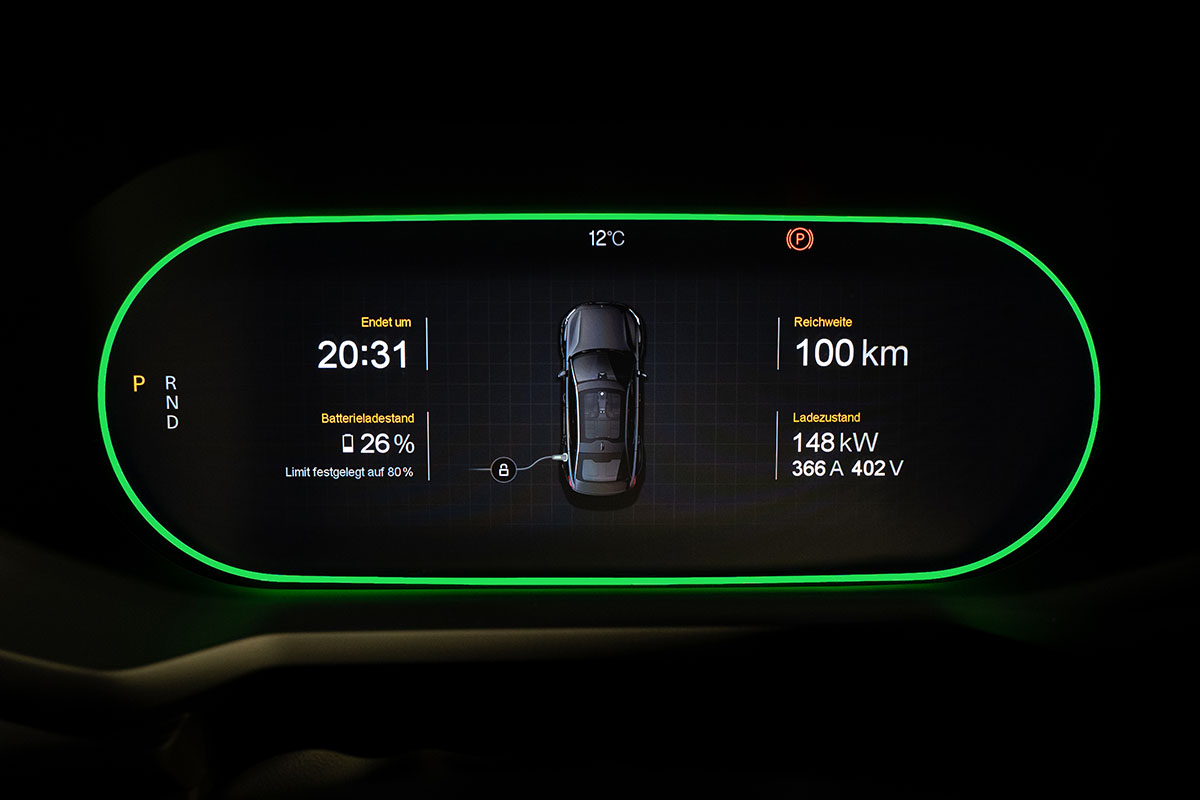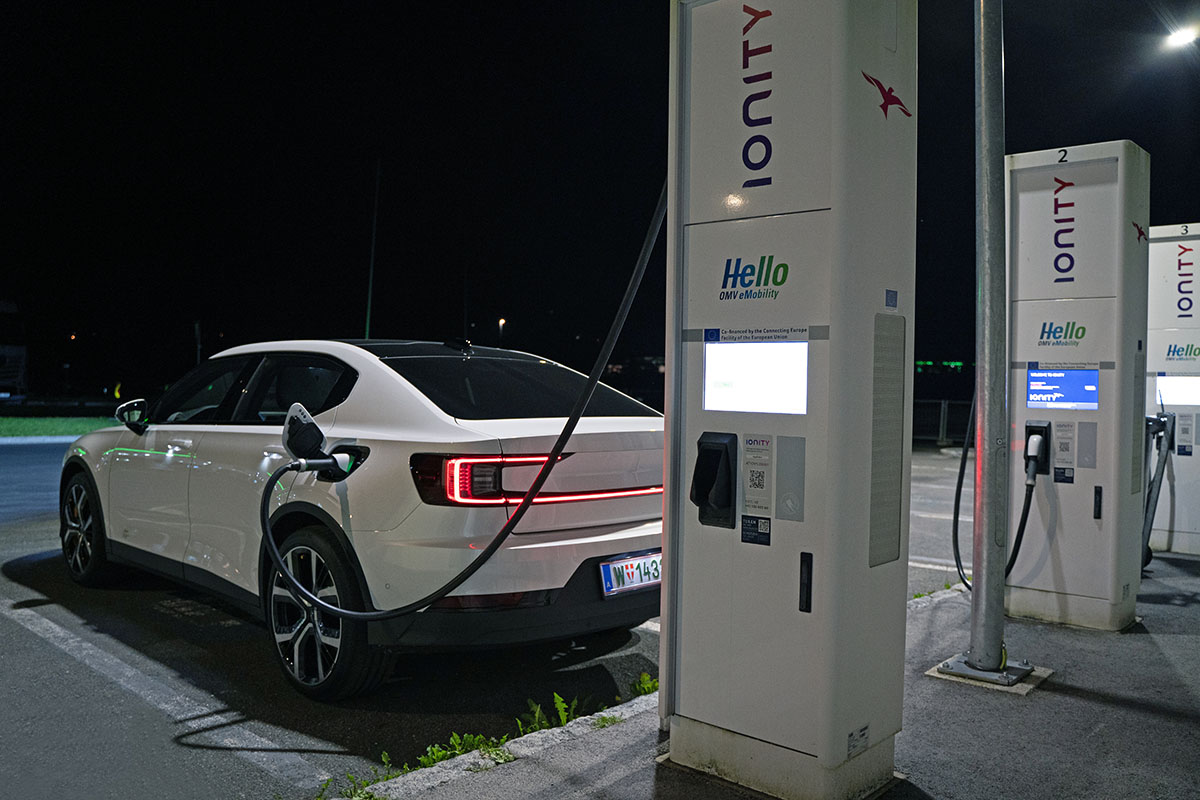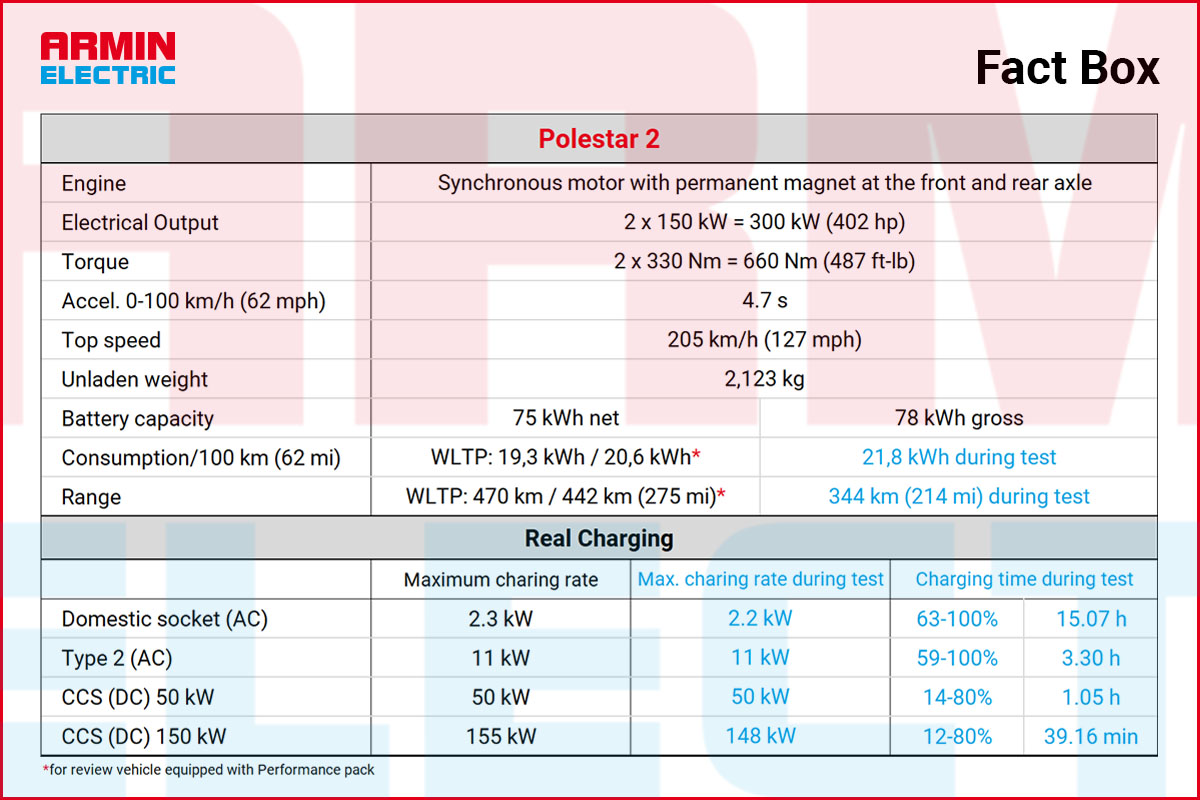Salzburg | Carinthia | Tyrol – At Grossglockner, where Austria will next meet the Pole Star, I’m travelling in the new, all-electric Polestar 2. The trip was a worthy finale to my season this year on the Grossglockner High Alpine Road. The experiences I had with that electric car up there…
Polestar Austria provided me with the Polestar 2 for this test. The car’s appearance captivates with its modern style and minimalist design philosophy. Numerous black elements compliment the “Snow” (Crystal White Pearl) colour. 20” forged alloy wheels with 245/40 tyres and gold brake callipers set off the rest of the car. The distinctive Pixel LED headlights contain 84 individually controlled LEDs per lamp and active cornering lights. At the rear, a continuous light band consisting of 288 individual LEDs completes the look.
From Salzburg, my journey took me south first on the Tauern autobahn. Via Wagrain and St. Johann im Pongau I drove to Bruck an der Glocknerstrasse, where I turned left into the Fusch Valley. On the day, the mountains in front of me were overcast. Despite that, I stuck to my plan and drove up to Hochtor pass. Three days later I had better luck with the weather. On a clear day I was back on the Grossglockner High Alpine Road, this time travelling to Kaiser-Franz-Josefs-Höhe – a vantage point on the route.
DRIVETRAIN AND BATTERY
The Polestar 2 is equipped with a dual-motor powertrain with two permanent magnet synchronous motors, which drive the front and rear axles. Both motors are identical, putting out a combined power output of 300 kW (402 hp) and 660 Nm (487 ft-lb) of torque. The battery is also outfitted with a liquid cooling system. A planetary gearbox distributes power across all four wheels. The motor controller considers all driving parameters to optimally distribute power between the front and rear wheels. The car accelerates from 0 to 100 km/h (62 mph) in 4.7 seconds. What impressed me was that the power never wanes on inclines; on the Grossglockner High Alpine Road, after the Ferleiten Toll Station, I hardly noticed the first steep climb. Powering the car is a lithium-ion battery, with 324 cells arranged over two levels, integrated into the underbody – the battery weighs 499 kilograms.
PERFORMANCE PACK ENHANCES DRIVING DYNAMICS
Fast corners on the road to Fuscher Törl proved no problem at all thanks to the car’s sporty character. Even when ambitiously accelerating out of corners the car kept to its line, only in a few cases could you hear some tyre squeal. The Continental SportContact 6 tyres, developed especially for the Polestar 2 and distinguishable by the “POL” label, paired perfectly with the Öhlins Dual Flow Valves (DFV) shock absorbers, ensuring the best possible performance. An extra hydraulic relief valve gives the shock absorbers distinctively sporty performance, as they can release increasing pressure almost instantly. Compression and rebound damping can be manually adjusted according to road conditions and preference. Polestar opted deliberately to go without an electronic suspension system, so as to allow for minute and driver-oriented fine tuning. A low centre of gravity is another significant factor in the way the car holds the road, this is due to the position of the battery and the near perfectly balanced weight distribution, with a ratio of 51:49 between the front and rear axles.
At 2,428 metres (7,966 ft) I soon reached Fuscher Törl, and after a short descent to Fuscher Lacke the road leads up again towards the Hochtor tunnel. Up there at 2,504 metres (8,215 ft) above sea level was where my first ascent a few days before had come to an end, this is where you cross the border between Salzburg and Carinthia while driving through the tunnel. When I came to charge at the free charging station, the station was out of order due to pipeline construction. Since I only had 14% battery charge (SoC) and the system estimated that I would only have 5% on arrival at the next charging station at Kaiser-Franz-Josefs-Höhe, I decided to head back. This time, however, I pushed on further towards Glockner. On the way down to the roundabout, full of winding corners, I was ideally equipped with the dual brake system. As soon as you apply pressure to the brake pedal (“Brake-by-Wire”), the electric motors in the regenerative braking system are activated, slowing the car through electro-magnetic resistance. If the braking power is not enough to match the force detected by the sensor when depressing the pedal, it instantly switches to hydraulic braking. In the case of the Performance pack, we are dealing with a Brembo braking system which was specially developed for the Polestar 2, consisting of front-side four-piston aluminium brake callipers and perforated discs.
ONE PEDAL WILL DO
With one-pedal drive, speed can be controlled with just the accelerator pedal. All you need to do is let off on the accelerator for the regenerative braking to bring you to a stop and recover energy for the battery. The function can be adjusted to two levels or turned off completely. I found the stronger “standard” setting to be the most pleasant. By activating Creep mode, the car will automatically move slowly after letting off on the pedal. After trying this out I decided to deactivate it, as I preferred to pull off with the accelerator pedal. In the “drive” menu the steering weight can be adjusted to three settings and Electronic Stability Control (ESC) can be changed to Sport mode, which reduces system intervention.
HIGH-END INTERIOR
Polestar’s connection to its cousin, Volvo, is evident when we come to the interior design. Simple and classical functionality dominates inside Polestar 2. High-end materials are used throughout, which is to be expected with the Polestar’s claim of premium quality. Only the “WeaveTech”, a vegan, water-based, PVC material, which is used for the seat upholstery, felt a little too rubbery for me. Those who feel the same can also opt for classic leather upholstery at a higher price point. In staying with the character of the interior, no futuristic elements were used in the design of the instrument panel, everything is exactly where you would expect.
Where analogue, round dials would be, there is a 12.3” driver display. Visual displays are tidier and simplified, it can be changed between two views, with or without map navigation. Here a greater selection would not go unwanted, particularly as you can bring up all the important information for your journey only through a dedicated menu, which cannot be shown on the display permanently. The 11.5” “free-floating” touchscreen is mounted in portrait orientation in the centre of the dashboard. There you can control infotainment functions: climate control, driving settings, navigation, telephone, and other apps. In the boot there is 405 litres of storage space; by folding the rear seats down, this can be expanded to 1,095 litres. There is a 35-litre storage compartment under the bonnet, which is best suited to storing the charging cable.
ELECTRONIC SAFETY SYSTEMS
As well as structural measures and 8 airbags in total, the comprehensive driving aids make a considerable contribution to safety. These can be simply and intuitively operated via the buttons on the left-hand side of the steering wheel. The adaptive cruise control keeps a chosen distance from the car in front by automatically regulating speed. The radar unit mounted in the radiator grille is located behind a heated panel, ensuring it functions even in winter driving conditions. Furthermore, Pilot Assist holds the car’s position in lane in optimal conditions with the help of cameras. In contrast, Lane Keeping Aid only interferes in steering when it signals that the car is close to crossing into another lane. In the event of an imminent collision, the braking assistant first uses audio and visual alerts to warn the driver, before decelerating the car to prevent a collision. The Road Sign Information feature works perfectly, however speed limits cannot be inputted via the buttons in cruise control. In danger of a collision, various other systems can rapidly flash brake lights, tighten seatbelts or bring the car to a halt.
THE ROAD TO THE CHARGING STATION
The Polestar 2 is the first car in the world to have the infotainment system “Android Automotive”, which was developed together with Google. Powered by Google Maps, it adds special functions for electric cars. During my first trip to Glockner, I inputted “Zell am See” as my destination while I was at Edelweissspitze. Navigation then recommended that I take a charging stop because the battery was running low. When I confirmed this, possible charging stations appeared on screen. As I only wanted to charge in Zell am See, I decided on the second option and was given information about my expected battery charge on arrival and for how long I would need to charge. After making my choice I was shown information on the selected charging station.
CHARGING ON ALTERNATING CURRENT
Meanwhile, my way along the Grossglockner High Alpine Road lead me from Hochtor pass down to the roundabout. There I turned right, taking the route to Kaiser-Franz-Josefs-Höhe. After reaching 2,369 m (7,772 ft) I came across a free “Kelag” charging station. In full view of Grossglockner Mountain, I was able to top up with a charging rate of 10 kW. According to the display, charging time there from 55% to 100% SoC (State of Charge) would have taken 4.5 hours. On the next day in Kitzbühel I achieved the maximum possible AC charging rate of 11 kW – in 3.5 hours I charged from 59% to 100%. With a domestic socket I drew a maximum of 2.2 kW, that charged the battery from 63% to full in around 15 hours.
DC FAST CHARGING UP TO 148 KW
On the first day I stopped at an ultra-fast charging station (up to 350 kW) in Salzburg, this one was a SMATRICS station at a McArthurGlen designer outlet centre. This station allows for multiple vehicles to charge at the same time, two or four cars can each achieve a charging rate of up 350 kW or 150 kW respectively. When I arrived, there were no cars using the station. Polestar states that the maximum charging rate for the Polestar 2 is 155 kW. Using my OMV E-Mobility card to start the charging process at 32% SoC was simple. To charge up to 80% it took exactly 32 minutes 54 seconds, that was 41 kW charged at a maximum rate of 115 kW. It’s likely that this wasn’t higher because I had started the charging process with a relatively high SoC.
In Zell am See I decided to use the suggested ”Salzburg AG” charging station at the Areitbahn car park, this station allowed for fast charging up to 50 kW. Charging there with the contactless Plugsurfing key was easy to do. At a rate of 50 kW, the battery charged from 14% to 80% SoC in an hour and 5 minutes.
I made another stop for a rapid charge at the Angath northbound service station in the district of Kufstein. The IONITY charging station there is run in conjunction with OMV. This station allows for 350 kW high power charging (HPC). I started the charging process at 12% SoC. After a short time, the maximum charging rate I reached was 148 kW, this held up almost until 30%. From 45% this dropped to under 100 kW and by the end at 80% it was still at 53 kW. In 39 minutes 16 seconds I had charged 56 kWh.
ARMIN ELECTRIC CONCLUSION
The Polestar 2 succeeds in every category as an electric car, the Performance pack above sets it apart as a sporty EV. The harmonised propulsion and a perfectly optimised chassis allow you to be ambitious in your driving style. Clean lines and the simplified interior with subdued, high-quality materials remind you of Polestar’s cousin Volvo. Only in terms of energy usage can this EV not keep up with its direct competition. During my test over a total 880 kilometres (547 miles), to determine my test usage I covered a route of 300 kilometres (186 miles) which may represent real usage. 80% of those were on major roads and the rest on the autobahn, travelling at up to 130 km/h (81 mph). There was a difference in altitude of 775 m between the highest and lowest point. Average usage evens out at 21.8 kWh/100 km (62 mi), which worked out to a range of 344 kilometres (214 miles).
In Austria the price of the Polestar 2 starts at €55,900 (£52.900 in the UK). That is in the Void (black) colour, every other colour costs an additional €1000, with the Performance pack setting you back another €6000. The Pilot and Plus packs are included in the starting price. All in all, the review vehicle cost €62,900 (taking the manufacturer’s share of the Austrian e-mobility subsidy into account). The first vehicles ordered online in Austria will be delivered in Autumn, with any necessary services being taking on by Volvo’s dealership network.
Text and photos: Armin Hoyer – arminonbike.com



